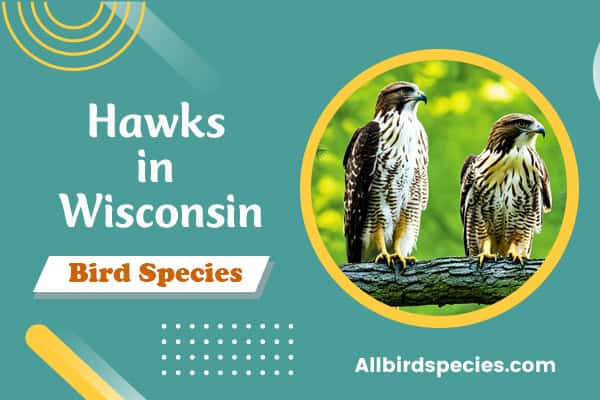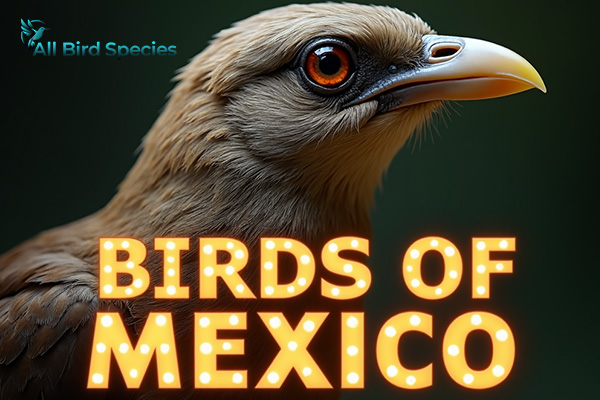Hawks in Wisconsin – 7 Common Species You Can Spot
Ever thought about how many types of hawks live in Wisconsin? These birds are not just pretty to look at. They are key to Wisconsin’s wildlife balance. They help keep the food chain in check.
Wisconsin’s varied landscapes are perfect for these birds. From dense forests to wide plains and wetlands, hawks find their home here. If you love nature or birdwatching, learning about hawks can make your outdoor time better.
The Fascinating World of Hawks in Wisconsin
Hawks have many adaptations that make them top flyers. In Wisconsin, you can see many hawk homes that help these amazing birds. Each hawk type has its hawk behavior suited to its home, playing a big part in Wisconsin’s ecology.
These birds are known for their sharp vision and hunting skills. They use different ways to catch their food, moving fast and agile in many places. Learning about their behavior helps us see how they keep local rodent numbers down and keep nature balanced.
Where hawks choose to nest tells us a lot about them. Some like deep forests, while others like open fields or cities. This shows how hawks can live in many places in Wisconsin, showing their strength and cleverness. When you look at their homes, see how they live with their surroundings.
Common Species of Hawks You Can Spot
In Wisconsin, hawk spotting shows off many beautiful common hawks. Each one has its own special features. This makes hawk identification fun and interesting. Here are some hawks you might see in the state and how to tell them apart.
- Red-Tailed Hawk: Known for its red tail and wide wings. They love flying over open fields and highways.
- Cooper’s Hawk: Quick and agile, they move through the woods. Look for their round tails and sleek bodies.
- Sharp-Shinned Hawk: The smallest hawk in North America. They stand out with their short, squared tail. You’ll find them in woodlands and gardens.
- Broad-Winged Hawk: These hawks migrate, so you’ll see them in spring. They have a big build and wide wings.
- Rough-legged Hawk: Comes to Wisconsin in winter. It’s easy to spot because of its feathered legs. They hunt for small mammals in open fields.
Using tools like eBird can make hawk spotting in Wisconsin even better. Their data shows where and when to look for hawks. So, grab your binoculars and enjoy watching these amazing birds!
| Hawk Species | Identification Features | Preferred Habitat |
|---|---|---|
| Red-Tailed Hawk | Redtail, broad wings | Open fields, highways |
| Cooper’s Hawk | Sleek body, rounded tail | Wooded areas |
| Sharp-Shinned Hawk | Small size, squared tail | Woodlands, gardens |
| Broad-Winged Hawk | Stocky build, broad wings | Forests, migrating paths |
| Rough-Legged Hawk | Feathered legs | Open fields |
1. Red-Tailed Hawk
- Scientific name: Buteo jamaicensis
- Life span: 10-15 years
- Size: (50-65 cm)
- Weight: (900-1460 g)
- Wingspan: (114-133 cm)
The Red-Tailed Hawk is a key bird in Wisconsin, seen all year. It’s known for its unique looks and how well it adapts. This bird is very important to the area’s nature.
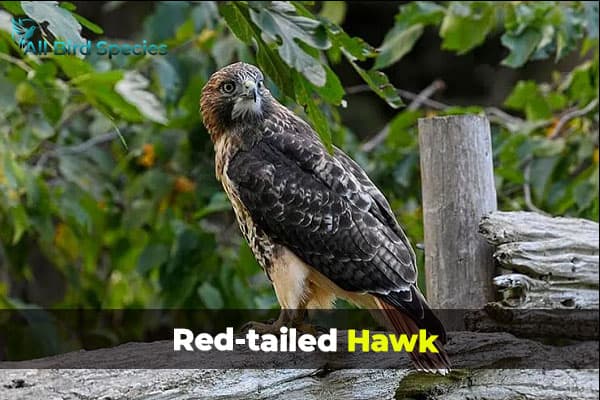
Identification Features
Identifying Red-Tailed Hawks is easy with their bright, reddish-brown tail. They also have a mix of brown and white on their bodies. Their wingspan can reach up to 4 feet, letting them fly smoothly.
Habitat and Nesting Behavior
Red-Tailed Hawks live in many places like open fields, deserts, and forests. They like to nest in tall trees or cliffs. Their nests are big and made of sticks, high up to keep their babies safe.
Conservation Status and Efforts
Conservation efforts have helped keep Red-Tailed Hawks safe. They were once in danger from losing their homes and being hunted. Thanks to laws and projects to fix their homes, these birds are still common in Wisconsin.
2. Cooper’s Hawk
- Scientific name: Accipiter cooperii
- Life span: 12 years
- Size: (37-39 cm)
- Weight: (220-410 g)
- Wingspan: (62-90 cm)
The Cooper’s Hawk is a bird known for its amazing agility and hunting skills. It has features that make it stand out in the wild. Look for the pale orangy bars on its chest and its blocky head. These are key signs to spot a Cooper’s Hawk.
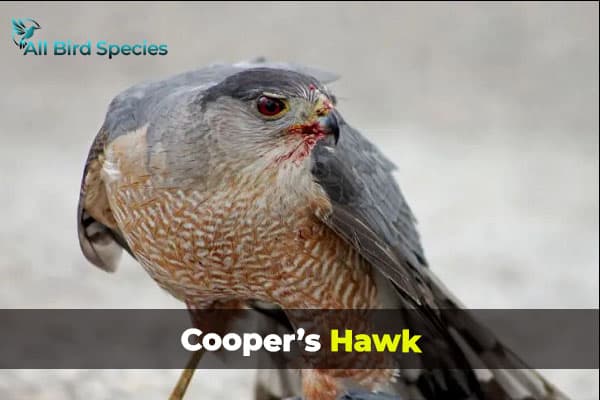
Characteristic Traits of Cooper’s Hawks
First, notice the Cooper’s Hawk’s size. It’s a medium bird, 14 to 20 inches long. Females are about 25% bigger than males. They have sharp talons and great eyesight for catching prey.
Their wings are rounded, helping them move through trees easily. This is key for hunting.
Preferred Habitat and Nesting
Cooper’s Hawks live in places with lots of trees. They like forests, woodlands, and even suburbs with many birds. They use these trees for hunting and making their nests.
They build their nests high up, hidden by the leaves. This shows how they adapt to different places. It helps them survive despite challenges in their homes.
3. Sharp-Shinned Hawk
- Scientific name: Accipiter striatus
- Life span: 5 years
- Size: (24-34 cm)
- Weight: (87-218 g)
- Wingspan: (43-56 cm)
The Sharp-Shinned Hawk is the smallest hawk in North America. It has unique tail patterns and a mix of colors. It is secretive and moves through forests to catch smaller birds.
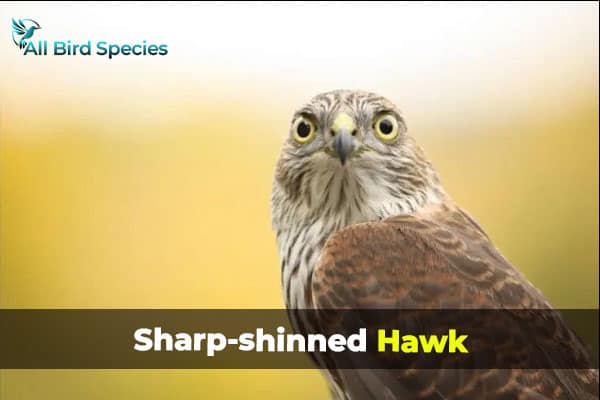
Identification and Behavioral Traits
Look for a squared-off tail and narrow wings to spot the Sharp-Shinned Hawk. It has a wingspan of 20 to 25 inches. Its sharp eyes help it see prey from far away.
This hawk is stealthy when hunting. It waits and then attacks quickly and powerfully on birds it catches off guard.
Nesting and Feeding Habits
Sharp-shinned hawks live in dense forests. They build their nests high up, using sticks and other materials. They mainly eat small birds like finches and sparrows.
4. Broad-Winged Hawk
- Scientific name: Buteo platypterus
- Life span: 12 years
- Size: (34-44 cm)
- Weight: (265-560 g)
- Wingspan: (81-100 cm)
The Broad-Winged Hawk is a bird that catches the eye in spring and summer. It has a dark brown body and a white-banded tail. These hawks are seen in large groups during their migration, showing off their unique flight patterns.

Distinctive Features and Migratory Behavior
This hawk stands out with its broad wings and short tail. These features help it fly agilely during its long migration. The Broad-Winged Hawk travels thousands of miles to find its breeding grounds. Watching them fly together is a sight to behold for bird lovers.
Nesting Practices in Wisconsin
Hawks In Wisconsin, the Broad-Winged Hawk’s nesting habits are quite interesting. They choose deciduous forests for their nests, where the trees protect them. The nests are high up, made of sticks, leaves, and other materials. During breeding, the male performs special displays to attract a mate. This shows how important their habitat is for their survival.
Hawks in other Regions:
5. Rough-legged Hawk
- Scientific name: Buteo lagopus
- Life span: Up to 15 years
- Size: (46-51 cm)
- Weight: (680-1470g)
- Wingspan: (132-137 cm)
The Rough-Legged Hawk is a winter hawks that visits Wisconsin during the cold months. It has amazing adaptations and hunting skills. These help it live and hunt well in harsh winter weather. When you watch these hawks, you’ll see how they can survive and find food.
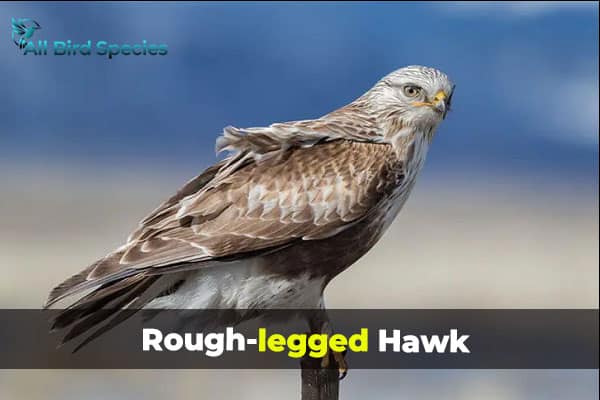
Adaptations for Arctic Survival
This hawk has special features to deal with the cold of the Arctic. Key traits include:
- Feathered Legs: These keep the hawk warm and safe from the cold.
- Coloration: Its dark brown and white feathers help it blend in with snowy scenes. This makes it a better hunter.
- Robust Body Size: Being bigger helps it keep warm in extreme cold.
Diet and Hunting Techniques
The Rough-Legged Hawk eats a variety of foods in winter. Its main foods are:
- Small mammals like voles and rabbits
- Birds, which are also an important food source
This hawk uses different ways to hunt:
- Perch Hunting: It looks for prey from a high spot, scanning open fields.
- Ground Hunting: It can hover and then dive to catch animals on the ground by surprise.
- Soaring: It uses warm air currents to cover a lot of ground with little effort. This helps it find food.
Related Video:
6. Northern Goshawk
- Scientific name: Accipiter gentilis
- Life span: Up to 15 years
- Size: (61-74 cm)
- Weight: (680-1360g)
- Wingspan: (114-132 cm)
The Northern Goshawk is a unique bird in the forest. It’s hard to spot because it blends in well. You can tell it by its white eyebrow stripe, bright yellow eyes, and colorful feathers. These features are hard to see from below the trees.
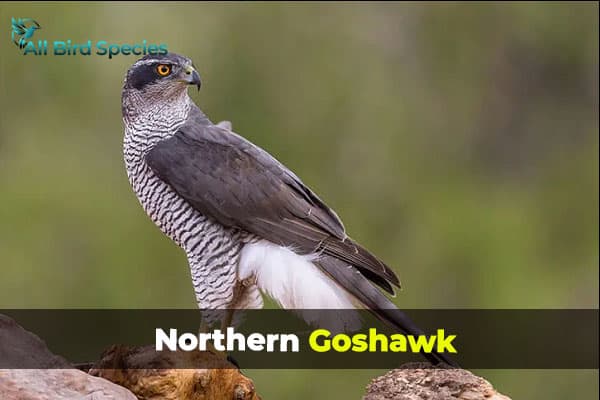
Identification Challenges and Characteristics
The hawks of Wisconsin are bigger than many others. It has wide wings and a long tail, perfect for flying through trees. These features help it hunt and move quietly. Its feathers also help it hide in the forest, making it harder to see.
Nesting Behavior and Diet
Northern Goshawks build their nests high up in big trees. This keeps them safe from danger. They eat small birds and mammals, making them good hunters. Knowing about their nests and diet helps us understand their role in nature.
7. Swainson’s Hawk
- Scientific name: Buteo swainsoni
- Life span: Up to 15 years
- Size: (46-56 cm)
- Weight: (650-1,100 g)
- Wingspan: (119-150 cm)
The Swainson’s Hawk is a true marvel of migration. It captures the hearts of bird watchers everywhere. Its long journeys are both elegant and strong. Spotting this hawk in the wild is a treat.
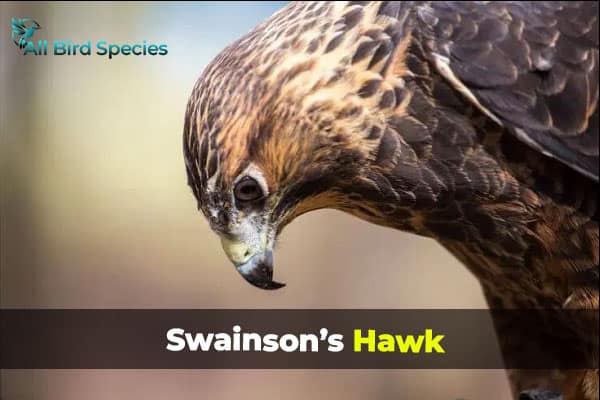
It has a dark bib and a brownish body. This makes it easy to recognize. It adds to the joy of birdwatching.
Identification Tips and Traits
To spot the Swainson’s Hawk, look for its unique features. The dark bib stands out against its lighter belly. This helps you see it soaring high in the sky.
These hawks love to ride the thermals. This shows off their amazing flying skills. Knowing how to spot them makes watching their migration even better.
Conservation and Habitat Preferences
Swainson’s Hawks like open grasslands and fields. These places give them plenty of food. But, they face threats like losing their homes.
There are efforts to protect them, though. By supporting these efforts, we can help keep the Swainson’s Hawk around. Let’s make sure they keep flying over Wisconsin and beyond.

